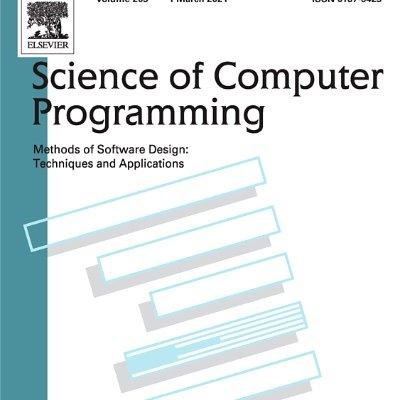
SCICO
@SCICO_journal
Followers
252
Following
30
Media
0
Statuses
384
Science of Computer Programming is dedicated to the distribution of research results in the areas of software systems development, use and maintenance.
Joined January 2021
Hanus introduces a fully automatic method for inferring non-failure conditions in declarative programs, such as calling partially defined operations with unintended arguments. An implementation for functional logic Curry programs is presented. https://t.co/mDuxp9Gkop
0
0
0
Kiselyov presents a 10-year retrospective of MetaOCaml, a superset of the OCaml language, or convenient code generation with static guarantees. The paper describes the current design and implementation, with a particular emphasis on notable additions. https://t.co/ZgHVPS14aQ
0
0
1
Almeida et al. generate tests for concurrent features by interleaving sequential test cases, using a new conformance relation to account for quiescent behavior. The resulting tests yield higher coverage and bug detection rates than those of developers. https://t.co/JcJFl3xV5q
0
0
1
Liu et al. introduce a multimodal vulnerability detector that fuses features from both source and binary code using an attention-based strategy. It was evaluated across three datasets in C, C++, and Java, achieving improved performance over 7 baselines. https://t.co/I1pWGzQVVZ
0
0
1
Porres et al. developed stgem, a Python library for developing black-box falsification and test generators for cyber-physical systems. So far, it has been used to develop 3 novel test generation algorithms and has been used in 5 research competitions. https://t.co/f5BHrXFBOE
0
0
1
Fan et al. combine TextCNN and the Kolmogorov-Arnold Network to identify extrinsic bug reports for improving JIT bug prediction. Evaluated on OpenStack bug reports, the model outperforms BERT and CodeBERT, with LIME analysis showing key predictive terms. https://t.co/OS995jo0Ef
0
0
1
Alsubhi et al. present Coconut, a C++ tool that enforces object behaviour correctness through typestate checking using GCC’s GIMPLE. An experiment on embedded systems shows that it improves performance and reduces code complexity w.r.t. unverified code. https://t.co/3d3ony8AjB
0
0
1
Azhir et al. introduce QualCode, an ISO/IEC 25010-based machine learning framework for software maintainability assessment. It was evaluated on diverse Java projects against existing tools, demonstrating superior performance. https://t.co/u5Dl9M60IT
0
0
1
Suárez-Brieva et al. present an SLR on "social debt" in software development, mapping 45 studies to its causes, effects, and detection strategies. The authors evaluate existing conceptual and automated tools used for identifying social debt. https://t.co/ydeB6MLOmG
0
0
1
Jiang et al. introduce CtxFuzz, a fuzzing technique guided by context-aware heap operation sequences, to expose memory bugs. CtxFuzz was evaluated on nine real-world programs against 7 SoTA fuzzers, uncovering more bugs and discovering 10 zero-days. https://t.co/7ipD6G64AZ
0
0
1
Pacheco Correa et al. analyzed the sampling threat when mining generalizable inter-library usage patterns. This is evaluated through simulations and a real-world case study, highlighting how restricting samples to specific libraries can skew results. https://t.co/hzGMGAwvtf
0
0
1
Crochet et al. introduce PANTHER, a modular framework for the automated testing and verification of network protocols. It was evaluated in a case study on the QUIC protocol, with reproducible experiments available for public use. https://t.co/5wqOFfDR3f
0
0
1
Tsakalidis and Vergidis surveyed 64 business process redesign (BPR) methodologies, assessing them on systematic design and generalizability. They propose the BPR Application Framework as a clearer, more actionable path for practitioners and researchers. https://t.co/U1ExvvwwDn
0
0
1
Duong et al. introduce an interactive dashboard for peer code review in a programming course. It was evaluated over a 17-week experiment, comparing dashboard users to a control group, showing improved engagement, performance, and instructor monitoring. https://t.co/vosu4NNu0o
0
0
1
Wijs discusses the SLCO domain-specific language and draws connections between the various research results. It presents an overview of various research topics and results demonstrating the framework’s application in component-based software development. https://t.co/j4dloR6S1l
0
0
1
Salimi et al. introduce a profit-aware, adaptive scheduling algorithm for heterogeneous multi-server CPS to meet deadlines and maximize system profit. Simulations show that it outperforms baseline methods in response time, profit, and deadline adherence. https://t.co/Eo9pLwuYAF
1
0
1
Liu et al. present ACInv, which combines static analysis and LLMs to generate loop invariants for complex programs. It solves 21% more cases than AutoSpec while matching its performance on numerical programs without data structures. https://t.co/mES3bU1mRU
0
0
1
López-Martín tested ML models to predict software design effort, addressing the lack of models specific to this SDLC phase. The best models were Support Vector Regression and Multi-layer perceptron NN on a dataset of seven public software projects. https://t.co/IDRENQteDi
0
0
1
Gholami et al. introduce a Case-Based Reasoning method using Repertory Grid Technique features to help software architects select patterns that meet specific quality requirements. The method achieved 83% accuracy in predicting the most suitable pattern. https://t.co/TglgG9asfW
0
0
2
Gómez Llanez et al. employ four design patterns in a Cognitive-Affective model to simplify serious game development. Evaluation through case studies, usability tests, and statistical analysis showed less development times w/o affecting training quality. https://t.co/hRHrj0o4hs
0
0
1